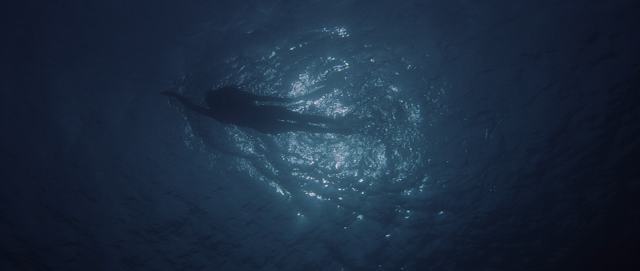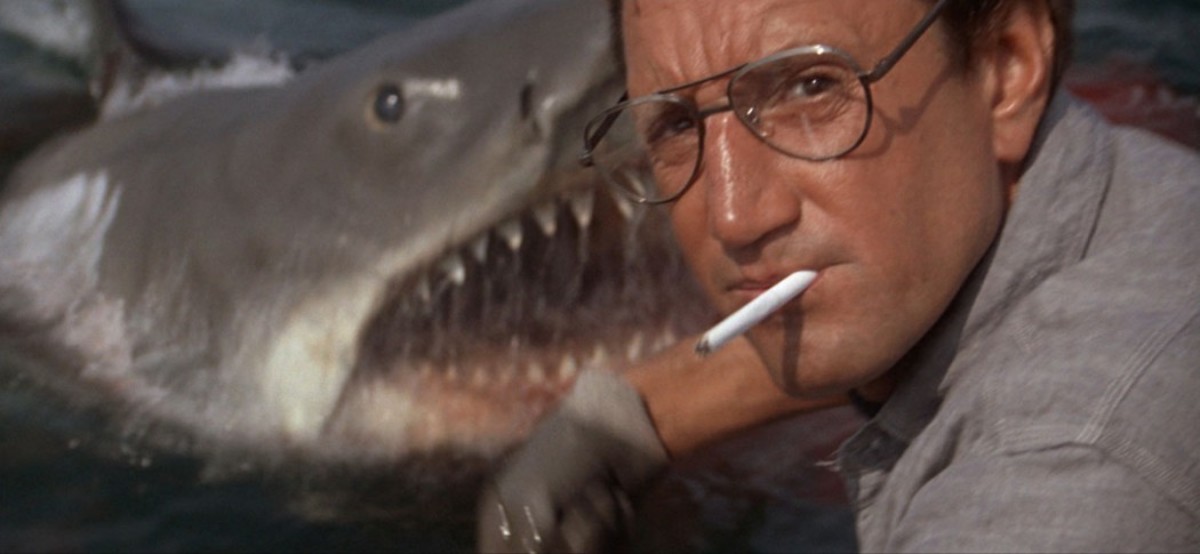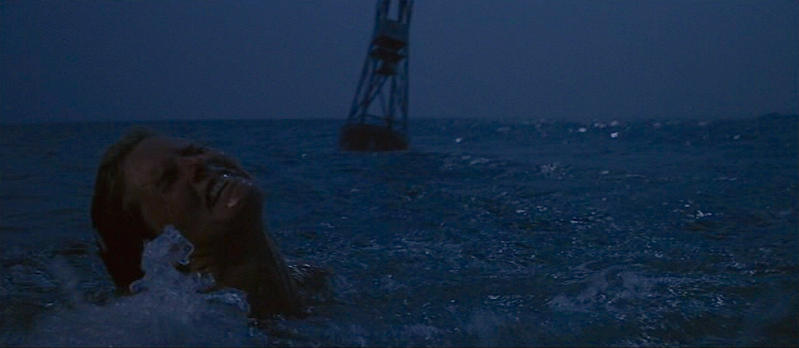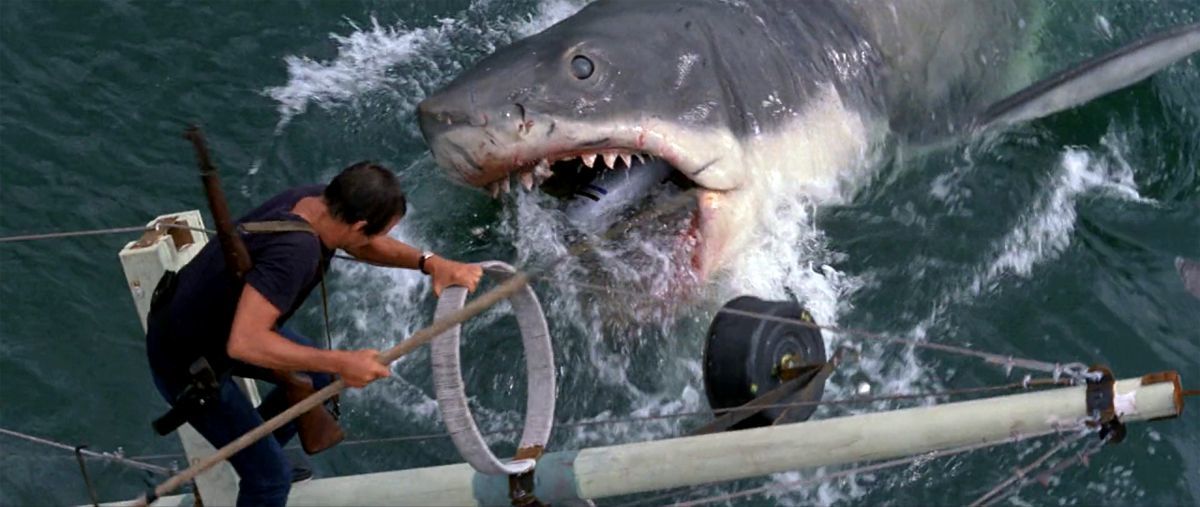By Amy Simmons
June 2018

Steven Spielberg ruined the ocean for me. Some people blame the director for spawning the high-concept summer blockbuster and for signalling the demise of the New Hollywood era. I blame him for a myriad of ruined trips to the beach.
When Jaws opened in the U.S. on June 20th, 1975, the film not only transformed the face of cinema – turning Spielberg into a household name – it would also change the way many of us perceived the sea. Four decades, and nearly $500 million in ticket sales later, Jaws still keeps audiences on the edge of their seats, has fans reciting the immortal lines, and leaves us wondering if it’s safe to go back in the water.
There’s no question that Spielberg’s landmark classic terrified at least a couple of generations of holidaymakers and fed harmful misconceptions of sharks. Scare stories of “rogue” sharks triggered headlines that added kindle to the embers of fear that Jaws had started, and as a consequence, dozens of shark fishing tournaments swept through the East Coast of the US, causing a calamitous drop in shark numbers. Subsequently, like Dr. Frankenstein, the book’s author, Peter Benchley, could not evade the carnage in the wake of his creation, and for the latter part of his career he became a voice in the campaign for the conservation of sharks until his death in 2006 at the age of 65. But that’s another story.
Out of all the films Spielberg has given us over his career – spanning nearly half a century – I would, perhaps controversially argue that he has never topped Jaws. Every shot, every scene, everything about the film is executed with such exquisite precision that I’m hard pressed to think of another “rouge animal” picture that has come anywhere near it, let alone better it. Eschewing the tiresome trope of sleazy characters getting what they “deserve”, Jaws is more than just a monster-movie, it’s also a superb black comedy and a gripping thriller, and unlike most modern blockbusters that frequently overwhelm viewers with nonstop “thrills”, Spielberg injects Jaws with highly suspenseful scenes and intimate character moments, and as a result, the bigger notes hit that much harder.
Raised on E.T. (1982) Close Encounters of the Third Kind (1977), Poltergeist (1982), and Raiders Of The Lost Ark (1981),I re-watched videotapes of Spielberg’s early films until they were worn out, at least until I discovered what else was out there. But for me, Jaws remains one of the truly great and lasting classics of American cinema, and one of the few films that left an indelible mark on my childhood. As such, I practically have it memorised– every line of dialogue and every musical note.
Since viewing Jaws for the first time, 37 years ago, I’ve tried to enjoy the ocean, but I just can not. I’ve tried breathing exercises, I’ve gone with friends and swam close by them the whole time. I’ve faked boldness in the hope that it would turn into real boldness. It hasn’t worked. I just think about sharks. And you can’t reason me out of it, I know the statistics.
The number of individuals who have been attacked is so small as to be considered statistically insignificant and does not warrant my anxiety – I realise that. I just feel like out of all the people bathing in the ocean, a shark would overlook everyone else, see my pale, lanky legs and wouldn’t hesitate to rip them off.
As Mayor Vaughn (Murray Hamilton) says to Chief Brody (Roy Scheider): “It’s all psychological – You yell barracuda, everybody says, ‘Huh? What?’ You yell shark, we’ve got a panic on our hands on the Fourth of July.”
I’m hardly alone in my lingering galeophobia (fear of sharks) and thalassophobia (fear of the open sea), for which I hold Spielberg singularly responsible. However, the deep-sea still represents the great unknown, and any venture into its waters is a relinquishment of control. “The fear of being eaten is ingrained in people,” says Mike Heithaus, a marine biology professor at Florida International University in Miami. “If we feel like we have some control or [a] fighting chance, a situation isn’t as scary. With sharks there are no trees to climb, and you can’t outswim a shark.”2

Before I’d even seen Jaws, I was terrified of its poster. Roger Kastel’s classic illustration of the gargantuan shark with its rows of razor sharp teeth, surging relentlessly towards the tiny, naked figure of the unwitting female swimmer, remains one of the most classic and iconic images of seventies cinema. Revealing so little, but suggesting so much, this horrifying artwork was a masterpiece of movie marketing. However, as visceral and affecting as the image undoubtedly was, it was also a bit of a tease. As many already know, Jaws turned out quite differently from how it was initially conceived. Shot mostly on location on Martha’s Vineyard in Massachusetts, the film had a troubled production. This was largely down to the mechanical shark – nicknamed Bruce, after Spielberg’s lawyer – failing to work for the majority of the – way over-schedule – shoot. Despite having three prop sharks that frequently malfunctioned due to bad weather, corrosive salt water and other problems, the brilliance of Jaws emerged from its impromptu, ad hoc nature, and it was Bruce’s numerous technical failings that led to the film’s unrelenting tension and saved it from becoming just another monster movie. Due to his prop’s shortcomings, Spielberg relied on a suggestive shooting style, an incomparably talented editor in Verna Fields, and heart-pounding score by John Williams (both Oscar winners) to construct a sense of presence-through-absence. As a result, the structure of Jaws is fairly reminiscent of a slasher film, in that the killer is largely concealed until the final act.

From the opening scene, Spielberg shot mostly from the point-of-view of the shark, allowing the audience to fully take part in the experience. Moreover, he utilised an ingenious series of immersive, “swimmers-eye” POV shots – with the camera dipping above and below the sea – to give us the sense of treading water, where even the briefest glimpse of a dorsal fin, coupled with ambiguous evidence of the sharks’ aggressiveness and enormous size, were sufficient enough to induce abject terror. Hence, like any savvy director experimenting with horror, Spielberg recognised the cinematic potential of invisibility and anticipation: an audience’s imagination would be far more effective than anything he created visually. Indeed, who’d have thought, that the sight of three yellow barrels popping up to the surface of the ocean, or the sound of a clicking fishing line could be so chilling?
By picking his moments to reveal the prop shark – on screen for a grand total of about four minutes – and using the power of suggestion, Spielberg was able to build a Hitchcockian sense of suspense. Thus, it is to young Spielberg’s credit (he was just 28 when he directed Jaws) that he pulled this off with aplomb, so much so that it’s easy to forget that we don’t get a good look at the shark until well into the second half of the film. Even so, for all his deficiencies, Bruce behaved as a movie monster should. It ate children and dogs, menaced the lead actors and even swallowed one whole in front of us. We knew the shark was fake, but when it launched itself at Chief Brody – when he was given the task of laying a chum line – we had a collective heart attack.

According to one of the film’s producers, David Brown: “Almost everyone remembers when they first saw Jaws.”
The film entered my life sometime around the age of eight, when it premiered on UK television on October 8, 1981. I was hiding behind the living room door at the time – when I should have been in bed – while my parents were watching the film. They had no idea I was there, in a state of sublime terror, daring to peak at every scene. When Quint (Robert Shaw) meets his macabre fate, as he slides down the tilted deck into the shark’s gaping maw, I was horrified, distraught and in complete awe. I had never seen anything so grisly in a film before – the sight of him coughing up blood in agony still haunts me – and it burned into my retina. This was a seminal event, which most likely started my love for the horror genre, and the memory of that shark stalking the waters off the richly realised world of Amity Island has never entirely released me. Still, like most children, I loved the things that scared me, and I developed a nearly pathological obsession with sharks as a result of the film. Wading into the ocean on family holidays filled me with horror, but I still read as much as I possibly could about sharks – and shark attacks, which particularly held a dark attraction for me. I guess my child’s brain was still processing the trauma of seeing Quint being devoured alive. That said, like many of my generation, I probably saw the film far too young, and it still astonishes me to this day that Jaws received an A (restricted to adults) in the 1970s and then was granted a PG (parental guidance) in the 1980s. Considering the film features – among other alarming scenes – the dismembered limbs of two victims and a child being violently consumed in fountains of blood, even the 12 A (suitable for children aged 12 and over) these days seems extraordinarily lenient.
Since its release, Jaws has attracted a significant amount of analysis, each argument seeking to expose the mysteries of a film that struck a nerve in the summer of ‘75 and went on to smash box-office records, nabbing rave reviews, three Academy Awards, and a Best Picture nomination in the process. In Benchley’s book, it reads like a morality tale about the hazards of adultery and the inability of an obsessed patriarch to manage his family and his community. As a film, it has been variously interpreted as a depiction of masculinity in crisis, a psychosexual/misogynist thriller with a distinctly phallic antagonist, a middle-class manifesto that only resolves itself when Quint perishes, to a post-Watergate paranoid parable about corrupt authority figures. But as a cultural phenomenon, the real story of Jaws is how a B-movie concept, creature feature, transformed Hollywood, and our summer holidays, forever.
The story is simple enough: playing out as a classic three-act drama, Jaws is largely a character-driven film about Amity Island Chief-of-Police, Martin Brody, who attempts to close the beaches, after a young woman, Chrissie Watkins (Susan Backlinie) is killed by a great white shark. When he is refused permission by Mayor Vaughan, who is more interested in making money over the July 4th weekend, he grudgingly agrees to keep quiet. As the body count builds, the ocean-fearing Brody puts his faith in two men who know more about sharks than he does: a marine biologist, Matt Hooper (Richard Dreyfuss) and a professional shark hunter, Quint, who agree to help Brody find and catch the beast. It’s both an adventure and quest; a horror story with an (initially) unseen monster; a family story of a father trying to protect his children; but ultimately, it’s about three men, a battered boat and a voracious shark.
In a film loaded with unsettling moments – the unexpected appearance of Ben Gardner’s dismembered head during a late night dive, the estuary attack on the boating instructor whose leg is bitten clean off, and of course, the shark breaching the surface while Brody chums the water – it may seem impossible to pick just one to hold up as the most memorable. But for me, it is the bone-chilling, opening sequence, now the stuff of legend, featuring a young Chrissie Watkins, whose late night swim remains one of the most gripping, brutal and bruising scenes ever committed to celluloid. So effective is this scene that none of the later attacks come anywhere near as close to its nerve-shredding intensity. It is also convincing enough to stand on its own as a short horror movie about lone teenagers in peril.
Glittering seas, and the halcyon days of summer are established in Spielberg’s first shot, which focuses on a group of shaggy teens hanging out around a campfire. The camera comes to rest on the face of a blonde woman, Chrissie – who smiles invitingly at a young man sitting nearby. As they engage in a flirtatious chase towards the shore, she strips off her clothes and dives into the ocean, while he fumbles with his shoes and belt, before collapsing drunk on the beach.
The water is calm and inviting; a bell tolls and the dawn sun peeks above the far horizon. Chrissie swims out further and rests. Next, the scene cuts to a rippling, underwater perspective, where the camera focuses voyeuristically on her naked, shimmering silhouette. It’s a sublime shot, so beautiful we know it can’t last.

As Chrissie treads water – her long hair trailing over her shoulders like the seaweed in the film’s opening title sequence – Williams’s ominous ostinato quickens as the camera approaches her scissoring legs. The following shot is slightly raised above water level, no doubt to register her reaction, of first astonishment then dread. On the first yank, Chrissie’s head is jerked backwards, but she remains above the surface. The camera cuts to a tighter close up as the second violent tug pulls her under the water. When she emerges, we barely have time to register her response before she is pulled completely under for the third time. The camera remains on top of the water for an agonising few seconds, before she resurfaces with a scream. Clenched in the jaws of the unseen predator, Chrissie is dragged across the width of the frame from left to right. The film then cuts to her inebriated pursuer, passed-out on the beach, making it clear that her cries for help are going to remain unanswered. We then cut to a wider shot as she is propelled across the surface of the ocean in a white plume of foam towards a ringing buoy, where in a brief respite, she clings on to it and prays for her life, before the shark comes back to take her. Her panicked final plea is cut off by the black water as she’s dragged under for the last time.
It’s excruciating. And as far as iconic death scenes go, it’s hard to beat.
In Hitchcockian terms, by keeping the shark offscreen Spielberg shows us the time bomb ticking under the table early on with Chrissie’s death, which dramatically heightens the feeling of unease. Likewise, the visceral impact of Jaws had a significant amount to do with the late, great editor, Verna Fields (fondly known as the “mother-cutter”), whose contribution was instrumental in maintaining the film’s flow – building tension and giving substance to the most fleeting of shots – leaving a near-matchless legacy.

A further example of Field’s editorial dexterity is illustrated in the film’s notorious beach scene, where, soon after Chrissie’s violent demise, an anxious Brody stares intently out to sea, his vision obscured by beach dwellers strolling in front of him. Here, Fields uses the passerby’s as natural wipes, cutting the shots to an unsettling rhythm, between Brody’s point-of-view and the ocean. Next, we get a flurry of images from the perspective of the coastline – Alex Kintner (Jeffrey Voorhees) paddling out on his raft, a young man playing fetch with his dog, a large lady floating on her back, a couple frolicking in the surf and a constant babble of Altmanesque, overlapping dialogue that requires and rewards intense concentration – but it’s only when the dog vanishes that the lurking presence is suggested, and by then it’s too late. When the shark finally does attack, we’re completely disoriented. The scene culminates in the film’s infamous retrograde zoom into Brody’s panicked reaction, and his nauseous realisation that he’s failed to save the child. The final image of Alex’s ripped and bloodied raft as it nudges the shore – rather like the dog’s abandoned stick floating on the water – is a potent one and provides a bloody punctuation mark to what is perhaps the film’s most masterful moment of suspense.
Aside from the film’s nearly flawless technical execution, a large part of what makes Jaws work, is its overflowing sense of life. Spielberg is fascinated by the complexities and contradictions of human nature, and the dialogue sparkles (between a cast he clearly sees as crucial collaborators) with an immediacy and wit that has never lost its charm. The smooth interplay between characters, often expressed with sight gags – from the Styrofoam cup versus beer can crushing scene, to the familial tenderness of the dinner-table interaction between Brody and his youngest son, Sean, who solemnly imitates his every move, to Quint and Hooper comparing scars, where Brody surreptitiously checks his appendix scar but remains quiet – were all the result of improvised sessions and often play out wordlessly, as all the best Spielberg moments do. Moreover, valuable contributions were made in all of the supporting roles: Lorraine Gary delivers a naturalistic, seemingly effortless performance as Ellen Brody; Murray Hamilton’s multifaceted turn as Larry Vaughn lifts the Mayor above the usual slimy politician; and the film’s minor roles are filled with remarkable, lived-in performances, where scarcely a single stray line fails to either reveal character or advance the plot.

When the film’s legendary third act takes us aboard Quint’s ramshackle boat, the Orca, Jaws expands organically into a subtle examination of class war, notions of masculinity and nature fighting back against humanity, as it becomes an heir to Herman Melville’s Moby Dick, while conjuring a 25-foot, three tonne creature that is part marine biology, part destiny. Shifting effortlessly between suspense, humour, and sheer horror, Spielberg’s direction vividly conveys the isolation of the characters at sea, the power of the beast at hand and the rich camaraderie and rivalry that builds between Brody’s quintessential everyman, Hooper’s privileged, oceanographic playboy and Quint’s unhinged, modern-day Captain Ahab. Here, time is taken to let these characters drive the story, and we can’t help but warm to them.
It’s well-known that the working relationship between Dreyfuss and Shaw was frequently antagonistic during the making of Jaws. Though Dreyfuss has since downplayed their rivalry, he has admitted that he was often goaded by Shaw on set – usually when drunk, which Shaw frequently was. As it turned out, this behind the scenes “feud” as Spielberg called it, had a constructive rather than detrimental effect on the film, resulting in a raw immediacy, which fed back into organic, prickly performances.
The duo allegedly made amends – much like their characters do – during the filming of Shaw’s celebrated USS Indianapolis speech, where he delivered a harrowing four-minute monologue which demands our unwavering attention. For me, the cabin sequence – in which Quint recounts the trauma of sharks picking off his companions from the sinking ship in WW2 – remains not only a masterclass in acting but one of the greatest moments in the history of American cinema, where, for a brief moment, we forget about the menace outside and witness Quint’s suicidal drive for revenge, while the mournful cry of a humpback whale rings out in the distance, as if nature itself were lamenting his fate.
The speech, conceived by Howard Sackler and written by writer-director John Milius, was initially eight pages long, which Shaw, a noted playwright, finally trimmed down to four. When he stumbled onto the set to shoot it, however, he was so drunk that Spielberg gave up filming. However, he came back the next day sober, and nailed the scene, in a faultless performance that will never lose its potency.
The glorious absurdity of the film’s climax is one of those great cinematic moments. It’s the closest Spielberg comes to modern blockbuster territory, but by that point, an instant of excess after two hours of unremitting tension and restraint feels more than deserved. As social conflicts and personal concerns fall away, Spielberg’s grim capacity for big-screen gore is illustrated once again, in a brutally evocative, prolonged and graphic scene, as Quint is finally eaten alive from the waist down, thereby fulfilling his Captain Ahab destiny.

Eventually, of course, the job gets done, finished by Brody, who, trapped on the boat alone – while Hooper is still underwater – throws an oxygen tank into the shark’s cavernous mouth, and takes pot-shots with Quint’s rifle from the ship’s sinking mast. When the tank explodes, taking with it our defeated shark, it all seems somewhat implausible, but then so much of the film is. Still, Spielberg, as always, does not attempt to convince us of realism in his fantastical scenarios; rather, he builds belief in the universe containing these events. Moreover, by attaching us to his characters – who bring vivid reality to our fears, our joys, our hopes, and our pain – he pulls us in through masterful manipulation of the medium, and makes us believe the impossible.
How easy it is, perhaps due to decades of inescapable media saturation, to take Jaws for granted. The three lackluster Jaws sequels (none of which were directed by Spielberg) and countless rip-offs, have no doubt tarnished the film’s reputation, but it would be unfair not to give the director his due. In the wrong hands, the film could have been a disaster. Instead, it was a triumph of creativity and collaboration that manages to seamlessly and subtly interweave intimacy with spectacle, turning pulp fiction into pop art. Certainly, no film about a man-eating shark should be this accomplished, this important, this memorable, or frankly, this faultless. Nevertheless, Jaws turned out to be one of the most perfect cinematic fables ever told, which not only captured my young imagination, but triggered my lifelong, bittersweet love-affair with cinema and the ocean. To this writer, Jaws remains Spielberg’s masterpiece.
Endnotes:
- https://saveourseas.com/update/living-with-sharks/ ↩
- https://news.nationalgeographic.com/news/2005/06/0615_050615_jawssharks.html ↩
No comments:
Post a Comment